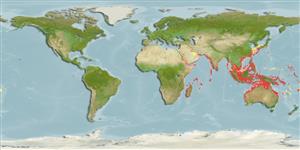Пластиножаберные (акулы и скаты) (sharks and rays) >
Myliobatiformes (Stingrays) >
Aetobatidae (Pacific eagle rays)
Etymology: Aetobatus: Greek, aetos = eagle + Greek, batis, batidos = a ray (Raja sp.) (Ref. 45335).
More on authors: Bloch & Schneider.
Environment: milieu / climate zone / depth range / distribution range
экология
морской; солоноватоводный донно-пелагический; амфидромный (Ref. 51243). Tropical
Indo-West: Persian Gulf to Borneo (patchy distribution).
Size / Вес / Возраст
Maturity: Lm ? range ? - ? cm
Max length : 72.0 cm WD самец/пол неопределен; (Ref. 4440); наибольший вес (опубликованные данные): 13.9 kg (Ref. 40637)
This species is characterized by the following: dorsal without spots or rings; long rostral lobe (longest in adult males) and narrowly pointed; disc very broad and short, its length 55-70% WD; pectoral fins weakly falcate and joining head at eye level, separate from rostral lobe; posterior margins moderately concave, rear tips free and broadly rounded; spiracles large, dorsolateral and visible in dorsal view; mouth ventral, its width narrower than preoral length; nasal curtain large, deeply notched centrally and with a curtain-like fringe; teeth plate-like in a single row, the upper teeth transverse, lower chevron-shaped; disc entirely smooth, no denticles or thorns; tail elongate, whip-like, ca. 1.2-2.8 times WD when undamaged; dorsal-fin small and raked back, apex broadly rounded, free rear tip short with origin behind pelvic-fin insertions; caudal stings 1 or 2, longest greater than preoral length. Colour uniform brownish or greenish brown, mostly white ventrally, pectoral tips and posterior margins of disc mostly pale brownish (Ref. 114953).
Inhabits inshore waters (Ref. 9862). Probably feeds on hard-shelled and bottom-dwelling invertebrates (Ref. 114953). Often found in brackish waters (Ref. 4832). Ovoviviparous (Ref. 50449). Caught occasionally by bottom trawl and inshore demersal gillnet fisheries off Jakarta. Utilized for its meat, but of limited value due to its rarity and small size (Ref.58048).
Life cycle and mating behavior
половая зрелость | размножение | нерест | икра | Fecundity | личинки
Exhibit ovoviparity (aplacental viviparity), with embryos feeding initially on yolk, then receiving additional nourishment from the mother by indirect absorption of uterine fluid enriched with mucus, fat or protein through specialised structures (Ref. 50449).
McEachran, J.D. and B. Séret, 1990. Myliobatididae. p. 67-70. In J.C. Quero, J.C. Hureau, C. Karrer, A. Post and L. Saldanha (eds.) Check-list of the fishes of the eastern tropical Atlantic (CLOFETA). JNICT, Lisbon; SEI, Paris; and UNESCO, Paris. Vol. 1. (Ref. 4440)
Статус Красного Списка МСОП (Ref. 130435: Version 2024-2)
Угроза для людей
Harmless
Использование человеком
рыболовство: не имеет хозяйственного значения
дополнительная информация
инструменты
Специальные отчеты
Скачать в формате XML
ресурсы в Интернет
Estimates based on models
Preferred temperature (Ref.
123201): 24.2 - 29.2, mean 28.2 °C (based on 1688 cells).
Phylogenetic diversity index (Ref.
82804): PD
50 = 0.6250 [Uniqueness, from 0.5 = low to 2.0 = high].
Bayesian length-weight: a=0.01000 (0.00244 - 0.04107), b=3.04 (2.81 - 3.27), in cm total length, based on all LWR estimates for this body shape (Ref.
93245).
Trophic level (Ref.
69278): 3.6 ±0.5 se; based on size and trophs of closest relatives
устойчивость к внешним воздействиям (Ref.
120179): низкий, минимальное время удвоения популяции 4.5-14 лет (Fec assumed to be <100).
Fishing Vulnerability (Ref.
59153): Very high vulnerability (85 of 100).
